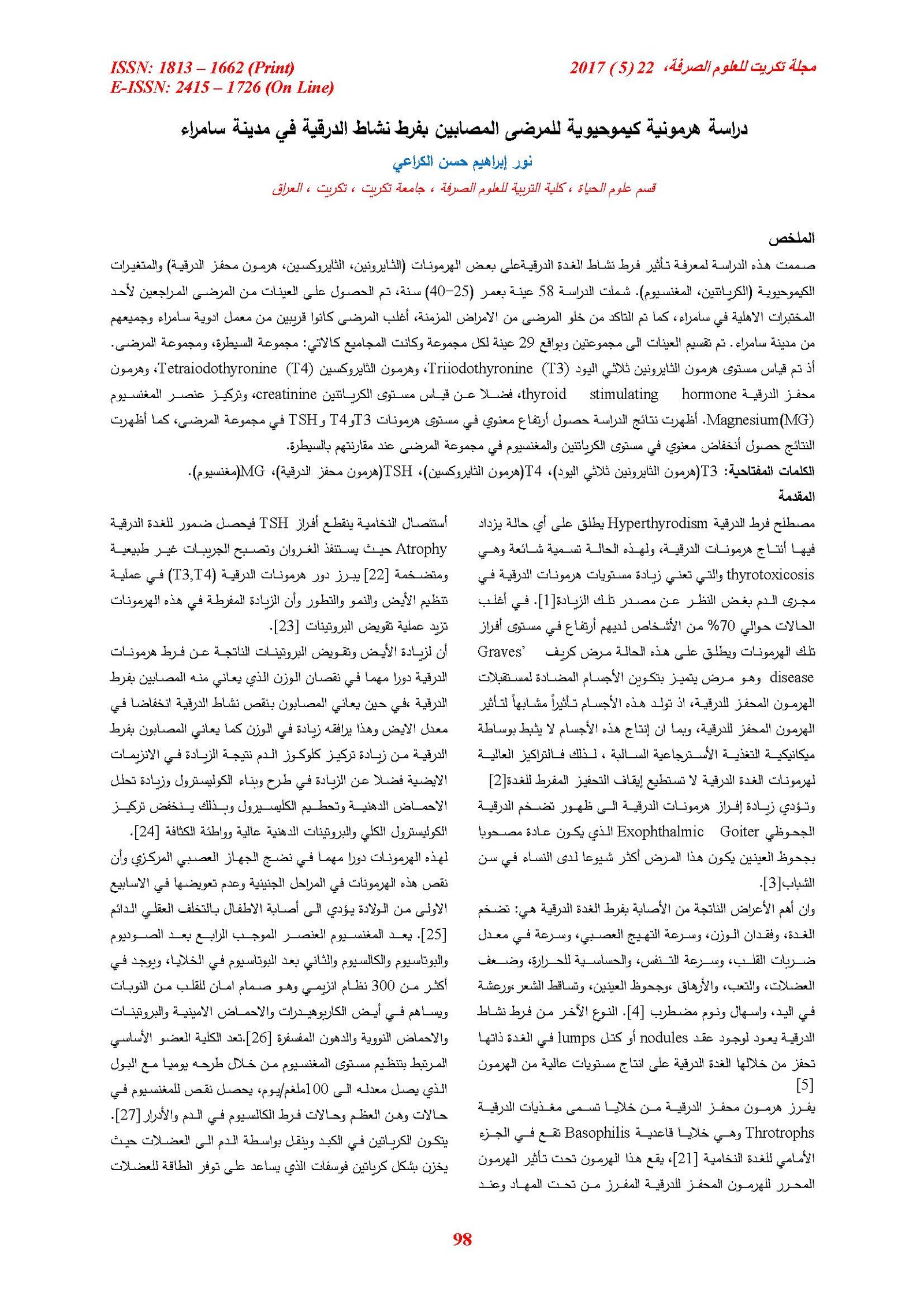Hormonal biochemical study of patients with hyperthyroidism activity in the city of Samarra
Main Article Content
Abstract
This study was designed to determine the effect of the increase of hyperthyrodisim on some hormones (Triiodothyronine, thyroxin, thyroid stimulating hormone) and some biochemical parameters (creatinine, magnesium) 58 sample used in this study at age (25-40 years), where the samples were divided into two groups and a sample rate of 29 per group. The totals were as follows: control group, and a group of patients. It was measured hormone Triiodothyronine level (T3), and hormone Tetraiodothyronine (T4), and thyroid stimulating hormone, creatinine and Magnesium. Results of the study showed for the increase significantly in the level of the hormone T3 and T4 and TSH in patients group, the results also showed a significant decrease for the level of creatinine and magnesium in patients when compared to the control group.
Article Details

This work is licensed under a Creative Commons Attribution 4.0 International License.
Tikrit Journal of Pure Science is licensed under the Creative Commons Attribution 4.0 International License, which allows users to copy, create extracts, abstracts, and new works from the article, alter and revise the article, and make commercial use of the article (including reuse and/or resale of the article by commercial entities), provided the user gives appropriate credit (with a link to the formal publication through the relevant DOI), provides a link to the license, indicates if changes were made, and the licensor is not represented as endorsing the use made of the work. The authors hold the copyright for their published work on the Tikrit J. Pure Sci. website, while Tikrit J. Pure Sci. is responsible for appreciate citation of their work, which is released under CC-BY-4.0, enabling the unrestricted use, distribution, and reproduction of an article in any medium, provided that the original work is properly cited.
References
1-Baskin HJ, Cobin RH, Duick DS, et al.(2002). (American Association of Clinical Endocrinologists). American Association of Clinical Endocrinologists medical guidelines for clinical practice for the evaluation and treatment of hyperthyroidism and hypothyroidism. Endocr Pract.;8:457-469.
2-Klein, J. and Levey, G.S. (2000) The thyroid .8th ed Philadelphia :Lippincott- Raven.
4-Rice, C.A. and Pollard, J.M. (2002) The important role cholesterol plays in your health. The health education rural out search.6:2-16.
5-Miller KK, Daniels GH. (2001). Association between lithium use and thyrotoxicosis caused by silent thyroiditis. Clin Endocrinol (Oxf).;55:501-508.
6-Duncan, RC; Knap, RG and Miller, MC (1983). Introductory biostatistics for the health sciences, A Wiley Medical Publication, John Wily and Sons. London, pp: 16-179.
7-Simon, H. (2006). Hypothyroidism. University of Maryland Medical center. J. Clin. Invest .112 (7): 1123 - 25.
8-Kumar, P. and Clark , M. (2004). Clinical medicine . 5th ed. W. B. Saunders comp. UK. pp : 1001-1039 .
9-Pagana, Kathleen, Deska and Pagana ,Timothy. (2002): Mosbys Manual of diagnostic and laboratory test. 2ed. Mosby
10-Miale, J.B. (2003). Laboratory Medicine Hematology. 6th ed., C.V. Mosby Company, pp. 354, 356, 360.
11-Ma, Y.; Freitage, P.; Zhau, J.; Brune, B.; Fred, S.; and Fandrey, J. (2004).Thyroid hormone induces erythropoietin gene expression through augmented accumulation of hypoxia inducible factor-1. AM. J. Physiol., 287: R 600- R607.
12-Guyton, A.C. and Hall, J.E. (2001). Textbook of Mecial Physiology. 10th ed., W.B. Saunders Company, Philadelphia, pp. 781-789, 858-868.
13-Hillman, R.S. and Ault, K.A. (1999). Alange Medical Book Hematology in Clinical Practice. 3rd ed, pp: 14-16
14-Tietz, N.W. (2000). Textbook of Clinical Chemistry. 2nd ed., Saunders Company, U.S.A. , pp. 132116
15-Disashi, T., Iwaoka, T., Inoue, J., Naomi, S. and Tomitak, K. (2001). Magnesium metabolism in hyperthyroidism. Endocr. J., 43(4): 397
18- Abdella, AM; Ekoon BS, Modawe GA(2013). The impact of thyroid dysfunction on renal function tests. Saudi J Kidney Dis Transpl ;24:132-134
20- Cano-Europa, E., Blas-Valdivia, V., Franco-Colin, M., Gallardo-Casas, C.A. and Ortiz-Burton, R.(2009). Methimazole induced hypothyroidism caused cellular damage in spleen, heart, liver, lung and kidney. Acta. Histochemica.
21- Larsen, P. R.; Krohenberg, H. M., Melmed, S. ; and Polonsky, L. S. (2003). Williams textbook of endocrinology 10th ed. Elsevier. Saunders. pp: 331-347.
22- Kumar, A. (2004). Animal physiology. Discovery publishing house. New Delhi. pp: 257-259.
23- Bullock, J. (2001). Endocrine Physiology. In: Physiology. Edited by Bullock, J., Boyle III, J. and Wang, M.B., 4th ed., Lippincott Williams and Wilkins, Philadelphia, pp. 693-706
24- Meier, C., Roth, C., Staub, J., Guglielmetti, M., Miserez, A. and Herzog, R. (2001). TSH-controlled L-thyroxine therapy reduces cholesterol levels and clinical symptoms in subclinical hypothyroidism: A Double Blind, Placebo-Controlled Trial (Basel Thyroid Study), 86(10): 4860-4866.
25- Becks, G.P. and Burrow, G.N. (1995). Diagnosis and Treatment of Thyroid Disease During Pregnancy. In: Endocrinology. Edited by DeGroot, L.J., VoL. 1, 3rd ed., W.B. Saunders Company, Philadelphia, pp. 799-820.
26- Weisinger, J.R. and Ezequiel, B. (1998). Magnesium and phosphorus. Lancet, 352: 391-396
28- Dewick, P.M. (2002). Medicinal Natural Products. 2nd ed., John Wiley and Sons, LTD, pp: 411.
29- Afifi, E.A., El-Sherbiny, E.M. and Tawfik, S.M.F. (2006). Evaluation of the and fibrinolysis in thyroid disease. Acta Haematol 1998, 58: 171-177.and Radiation Research.38 (4).
